|
|
|
|||
|
|
||||
|
|
||||
| The (Jet)X Files | ||||
|
|
HOME | SITE MAP | FORUM | CONTACT |
|
||
|
ABOUT | MOTORS | MODELS | ARCHIVE | HISTORY | STORE | FAQ | LINKS
|
|
|
|
|
|
|||||||||||||||||||||||||||||||||||||||||||||||||||||||||||||||||||||
|
The (Jet)X Files 20
(August 2004)
by Roger Simmonds Reprinted from SAM 35 Speaks, August 2004 Afterburning Peter Tolhurst, evidently as enamoured of the CO2 propelled ‘Speedjet’ as Tony Brookes had been, writes; “Your article last month (June) galvanised me into action. I have just finished drawing up a 7.5’’ version for Rapier L1 (with catapult launch), albeit with a profile fuselage. I know … you don’t like profile models, but this isn’t a scale model of a ‘real’ aircraft”. I look forward to seeing how Peter’s ‘hybrid’ trims out and performs at our SAM Gala. |
|
|||||||||||||||||||||||||||||||||||||||||||||||||||||||||||||||||||||
|
Apropos of catapult models, illustrations of three period profile models recently arrived from Sten Perrson. These attest to the popularity of jets in Scandinavia, and that Isacson was not the only endogenous kit producer at this time. To pre-empt Funf, the designer’s name does suggest a not inappropriate pun (true design?)! What is most intriguing is that though these nicely prefabricated kits were for catapult launch, Jetex power was also presented as an option. The rather fanciful illustration [below right] might possibly be a 50C. This rather contradicts the received wisdom that catapult gliders and Jetex models need setting-up in different ways. |
 |
|||||||||||||||||||||||||||||||||||||||||||||||||||||||||||||||||||||
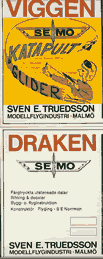

Stan Pearson comments: “I never thought Jetex and catapult power were compatible. The slower Jetex models needed several degrees of incidence, akin to a rubber job, whilst the catapult variety trim out (if you are lucky!) closer to zero-zero”. Stan has more to say about his early catapult jets (see last month): “The MiG 15 replaced one that went OOS in Richmond Park; at I loved Green’s books as a boy (knowing his Fighters of WW II practically by heart) and have a precious first edition of Jet Aircraft of the World. It is a fascinating compilation of pre-1955 jets (see the Hawker P.1081 3-view in April’s article); but Stan is right about the smaller drawings; that of the Leduc 021, for example, is particularly misleading. |
|
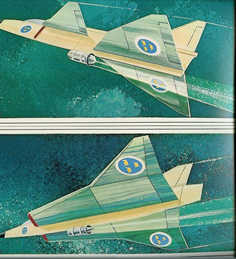 
- Sten Perrson
|
||||||||||||||||||||||||||||||||||||||||||||||||||||||||||||||||||||
|
Fortunately, most modern publications are better in this respect; Tony Buttler’s British Secret Projects: Jet Fighters since 1950 (Midland Publishing, 2000) has many unique 3-views and illustrations, including the Sapphire powered (though subsonic) Hawker P.1091 (right) and the mildly supersonic P.1083 (below right). Both these Hunter derivatives can easily be adapted (see last month's discussion of the P.1083) from period Hunter plans. The P.1091 is very shapely, and the delta wing will give stable and probably spectacular flying characteristics. Another ‘must have’ book is British Experimental Turbojet Aircraft by Barry Jones (Crowood Press). Its many large 3-views of prototypes, from the Gloster Whittle to the TSR 2 and Hawker P.1127, are in full colour and provide an excellent source of templates for homemade decals. Whilst on the subject of transmuting old plans, Andy Blackwell has just finished a KeilKraft Attacker, and thinks it would not be too difficult to convert this to the Scimitar-winged H.P.88. This research vehicle for the Victor bomber will make a very attractive model, especially if finished in the prototype’s dark blue. He also thought a Fairey Delta F.D.2 could be modified to a BAC 221. The Concorde-like wing planform should make for interesting flying characteristics. There are many other possibilities, of course, and plastic modellers have long been expert at this sort of thing. There are several derivatives of the Javelin, for example, or an F-104 could be modified to the shoulder-winged Lockheed X-27 CL-1200 Lancer, with beneficial effects on its flying characteristics – but please, please, don’t even contemplate turning a P.1A or P.1B Lighting into the horrible ‘boiler plate’ S.B.5, complete with fixed undercarriage! |
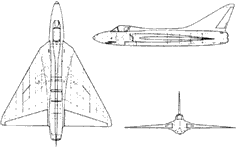 
- British Secret Projects: Jet Fighters since 1950
|
|||||||||||||||||||||||||||||||||||||||||||||||||||||||||||||||||||||
|
|
|
|||
|
John Bowring has built a ‘full size’ Veron Air-o-jet, and as the original was for Jetex 100, decided to use a Rapier L4, with a not, alas, an altogether happy outcome. John writes: “After test gliding on Saturday evening, I took it to Old Warden on Sunday. This has broken my rose tinted glasses. Out of ten L4s (two boxes) the first three were used to test fly; the next three at least lasted the length of the flight, without much attempt to climb, the seventh was better, having tinkered with the thrust line, and on the eighth flight it climbed away for about twelve seconds, then went into reverse. This didn’t last long, as the end pug had blown out of the motor and the exhaust blew a hole in the nose block. Flight number nine followed a similar pattern, only this time it set fire to the pod. I have one motor left, any suggestions?” I told John that L4 fliers used to ‘superglue’ both ends (of the motor). John replied, “I Araldited the ends of my tenth motor. The Air-o-jet climbed to 30-35 feet, and then came down almost as quick, but it was the best flight so far, and I will quit while ahead. The L4 doesn’t seem to have the thrust of the old Jetex 100, so now for something completely different”. This is a pity, as John has made a fine replica of Phil Smith’s early 1949 design. We have all had faulty motors (remember Rapiers are a product of a ‘cottage industry’) and it is good practice to inspect each motor for splits, asymmetric nozzles and the like. I have only had one blow-out; this was a standard L2, and the bang came as quite a shock, as I was holding the Bell |
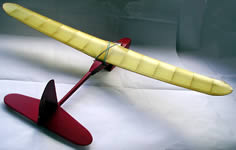
- John Bowring
|
|||
André Bird has had many wonderful flights with the L4, and is expert at getting the best from his unusual models. He has sent me details of a gadget that facilitates adjustment to the motor thrustline.  The wire (W) is affixed to the fuselage (F) and motor tube (MT) and kept under tension to abut the Rapier against packing (P). André says his models fly well with thin card wedged in to adjust the motor angle, but a nice refinement is to add bolt (B), which makes small increments of thrust angle both easy to ‘dial up’ and repeatable. |
||||
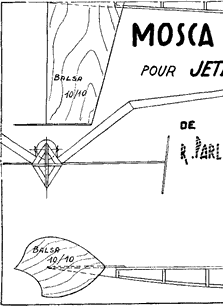
The designer, one Monsieur R. Parlatoré, comments, “Mosca has a slightly supersonic look about it [?] … the motor is mounted in the upper part of the fuselage, which positioning has absolutely no detrimental effect on Mosca's flying capabilities, and my fingers appreciate staying in the cool”. Please let me know if you would like a better copy of the plan to build from. Jigtime |
|
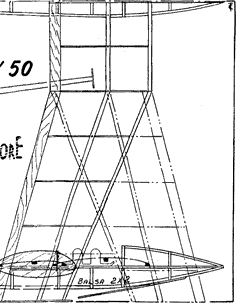
- Le Modèle Réduit d'Avion, October 1953
|
||
|
No, not a dance, but a series of prefabricated all-sheet kits for the fledging flier created by Carl Goldberg in the 1950s. These featured tabs and slots as neat aids to building, and the coloured balsa parts came with all markings pre-printed. Most designs were for rubber power; for example the Piper Vagabond and Curtis Like the Swedish Semo products, they were advertised for “Jetex and catapult”, but what is more interesting is that they were contemporaneous with, and similar in construction to, Jetex ‘Tailored’ models. I wonder if Carl Goldberg was influenced by Joe Mansour’s creations? The balsa shells are mounted on formers, but, in contrast to the Wilmot Mansour models, they were Paul Bradley’s superb website (www.parmodels.com) reviews the history of the Jigtime series in some detail, and many of the plans can be downloaded. Paul’s reproductions of the Superform models have planked octagonal fuselages, not moulded monocoques [see the F-86 and MiG 15 below], but this is a reasonable compromise in the circumstances – and their all-sheet construction makes a pleasant change from the usual ‘Flying Scale’ designs. Rick Carnick in the US has an |
 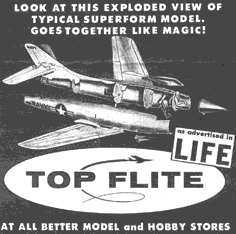
- Model Airplane News, Dec. 1954
|
|||
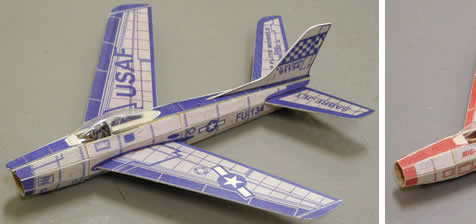 The next (Jet)X Files will review a fascinating historical series of articles, ‘Jet Propulsion and the Model’ written by G W W Harris, G A Henwood, R H Eaton-Williams and others that appeared in the source between 1945 and 1949. |
|

- Paul Bradley
|
||
|
|
||||
|
|
|
|||
|
|
|
|
|
|
|
|
Acknowledgements - Article: Roger Simmonds - Illustrations: Roger Simmonds, Sten Perrson, Mike Stuart, Chris Strachan, Andy Blackwell, Leigh Richardson, John Bowring, André Bird, Edward Jones, Paul Bradley |
|
|
|
|
ABOUT | MOTORS | MODELS | ARCHIVE | HISTORY | STORE | FAQ | LINKS |
|
|
Terms of Use
|
Queries? Corrections? Additions?
Please
contact us.
|
|